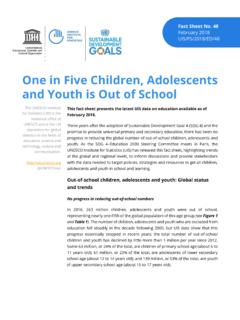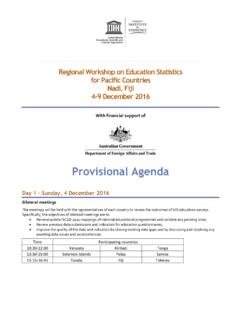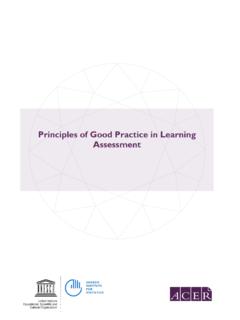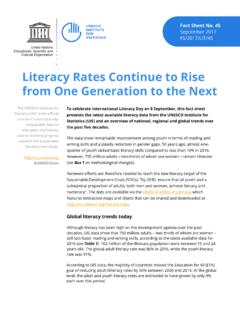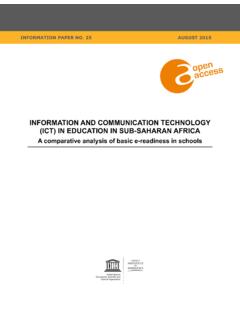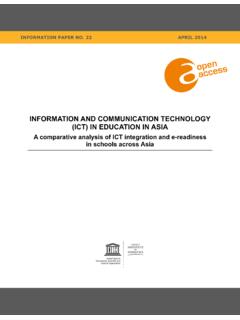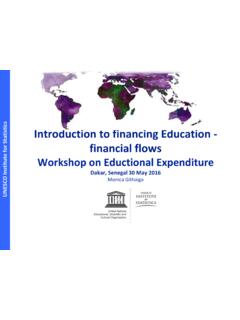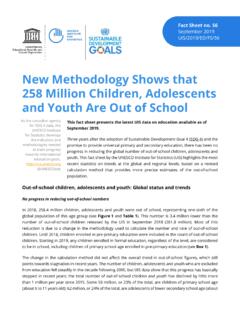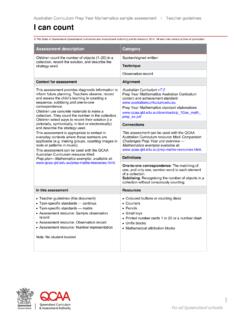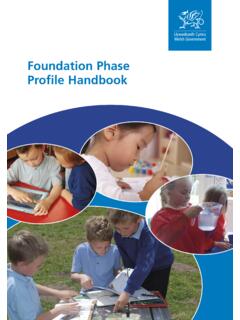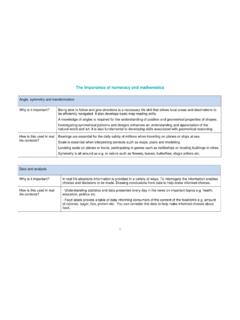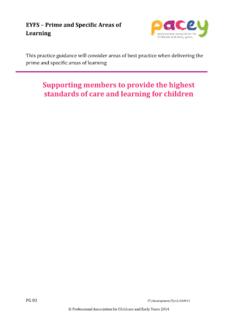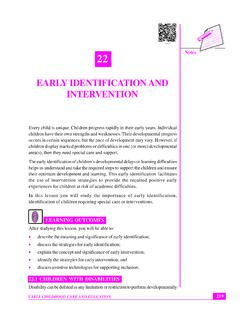Transcription of Children Out of School - UNESCO
1 One hundred and fifteen million primary School -age Children are out of School according to a joint global estimate by the UNESCO Institute forStatistics (UIS) and UNICEF cited in this report. This number equals 18% - or almost one in five - of the Children worldwide in this age report aims to improve our understanding of how many Children are out of School and who they are. It presents a new methodology forcounting the number of Children who are out of School and explores the link between participation and the characteristics of Children and thehouseholds in which they live. Data from across a large number of less developed countries reflect disadvantage in terms of participation inprimary schooling by gender, location of residence and household report also shows that efforts to widen access to primary education must recognise the different types of out-of- School Children , ,those who never enter a School , those who start late and those who leave School early.
2 Different contexts call for different types of the profile of out-of- School Children can vary widely across countries. Thus, understanding the proximate determinants of out-of-schoolstatus are important to planning policies aimed at reducing the number of Children excluded from United Nations Children 's Fund (UNICEF) is an agency that aims to help Children living in poverty in developingcountries, including the care and stimulation they need in the early years of life, and protection from illness, war andnatural Out of School :Measuring Exclusion from Primary EducationUNESCO INSTITUTEforSTATISTICSCHILDREN OUT OF School :MEASURING EXCLUSION FROM PRIMARY EDUCATION The UNESCO Institute for Statistics (UIS) is the statistical office of the United Nations Educational, Scientific and Cultural Organization ( UNESCO )and is the UN depository for internationally comparable statistics in the fields of education, science and technology, and culture Institute for Box 6128, Succursale Centre-VilleMontreal, Quebec H3C 3J7 Exclusion from Primary EducationUNESCO Institute for Statistics, Montreal, 2005 Children Out of SchoolUNESCOThe constitution of the United Nations Educational, Scientific and Cultural Organization ( UNESCO )
3 Was adopted by 20 countries atthe London Conference in November 1945 and entered into effect on 4 November 1946. The Organization currently has 191 Member States and six Associate main objective of UNESCO is to contribute to peace and security in the world by promoting collaboration among nations througheducation, science, culture and communication in order to foster universal respect for justice, the rule of law, and human rights andfundamental freedoms that are affirmed for the peoples of the world, without distinction of race, sex, language or religion, by theCharter of the United fulfill its mandate, UNESCO performs five principal functions: 1) prospective studies on education, science, culture andcommunication for tomorrow s world.
4 2) the advancement, transfer and sharing of knowledge through research, training and teachingactivities; 3) standard-setting actions for the preparation and adoption of internal instruments and statutory recommendations;4) expertise through technical co-operation to Member States for their development policies and projects; and 5) the exchange ofspecialised is headquartered in Paris, Institute for StatisticsThe UNESCO Institute for Statistics (UIS) is the statistical office of UNESCO and is the UN depository for global statistics in the fieldsof education, science and technology, culture and was established in 1999. It was created to improve UNESCO s statistical programme and to develop and deliver the timely, accurateand policy-relevant statistics needed in today s increasingly complex and rapidly changing social, political and economic is based in Montreal, Nations Children 's Fund (UNICEF)
5 As a vital member of the UN system, UNICEF works in more than 150 developing countries and territories, has National Committeesin 37 industrialized countries and more than 300 UNICEF Goodwill Ambassadors - all dedicated to improving the lives and well-beingof Children and advancing the Millennium Development in 1946, UNICEF is unique among world organizations, and unique among those working with the young. Through awide and diverse network of partners, UNICEF strives to protect and promote the rights of Children through its policies, programmesand advocacy. Its yearly report on The State of the World's Childrenhas presented the world's most comprehensive database on childrenfor the past quarter of a its many initiatives, UNICEF is the lead agency and secretariat for the United Nations Girls' Education Initiative, launchedby the UN Secretary General in April 2000 at the World Education Forum in Dakar.
6 With 13 core partners, UNGEI is the flagship ofEducation for All, emphasizing girls' education in the international effort to ensure the Millennium Development Goal of universalprimary education by is based in New York, United States of in 2005 byUNESCO Institute for Box 6128, Succursale Centre-VilleMontreal, Quebec H3C 3J7 CanadaTel:(1 514) 343-6880 Fax:(1 514) 343-6882 Email: 92-9189-026-X UNESCO -UIS 2005 Design:JCNicholls Design by: Imprimerie L EmpreinteRef:UIS/AP/05-033 ForewordThe Education for All Campaign and the Millennium DevelopmentGoals have focused the world s attention on ensuring that no childis excluded from receiving a primary education.
7 However, despiteglobal efforts to promote universal primary education, there werestill 115 million Children of primary School age out of School in2001/02. Globally, million girls of primary School age were notin School , accounting for 53% of the total number . The greatestabsolute numbers of out-of- School Children were found in sub-Saharan Africa (45 million) and South Asia (42 million). This report seeks to assess better the magnitude of the problem andmonitor progress towards the 2015 education targets. The need toproduce a single, authoritative figure on out-of- School Children wasan important starting point for this joint UNESCO Institute forStatistics (UIS) and UNICEF effort.
8 The new estimates presented in thisreport address deficiencies in both the methods and data usedpreviously. But, it also seeks to go much further. By recognising theneed to critically review existing data at the national level and toconfront or integrate data from different sources for more robustresults, it is hoped that this report will act as a catalyst for aproductive dialogue to improve the quality of national andinternational education measures. Indeed efforts are needed in order to improve the way that childrenout of School are counted, but they are also needed to provide amore detailed picture of these Children . The global count is importantfor monitoring progress.
9 Yet at the same time, it is essential to viewthe child and household as units of analysis in order to reassess orformulate new national policies which will lead to change at thecommunity level. This perspective requires a range of data this report pays great attention to numbers of out-of-schoolchildren, it is clearly not enough to simply enrol Children into schoolbut to ensure that they complete primary schooling equipped witha comprehensive set of basic literacy and numeracy skills. Thus,measures of out-of- School Children need to be studied alongsidemeasures of education quality and learning is essential to better understand the reason whychildren are not in School in the first place.
10 In manycountries, even those with high out-of- School rates,many of these Children have had some contact withschooling. For example, in Malawi 91% of childrenhave been in School at some time, but only 31%reach grade 5. The report estimates that globally,one out of three Children who are currently out ofschool will or have already received some primaryeducation. In other words, the education systemoften connects with the child but not at theintended age or for the intended is therefore imperative to focus policy attentionon the key education transition points (entry,progression and completion) within the context ofstages of child development.
